The Boothbys and the Swan Inn, Kettleshulme
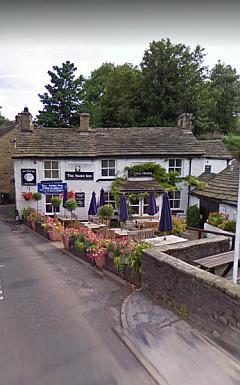
Since I wrote my other family history pages, I have been asked more than once what I know about the Swan Inn in Kettleshulme, its history and the Boothby family who ran it at one time. The answer is 'not very much' but these notes document what I do know: any contributions are welcome.
The Inn itself at one time claimed to be a 'fifteenth century coaching inn', and it certainly has the appearance of a building of that era, but documented facts about its history before the 1840s seem to be scarce. If anyone can add anything to this page I would be very pleased to hear from them. An 1829 directory of Cheshire does not even bother to list Kettleshulme.
The name 'Swan(n) Inn' does not appear in Census records until 1851; an 1850 directory refers to the 'Swan with two Necks' - however, this is possibly an error byanalogy with other Cheshire pubs of that name. The 1849 Tithe records for Kettleshulme, and all other mentions I can find, simply refer to 'The Swan Inn' or 'The Swann Inn' - and it is perhaps significant that by 1841 a Swann family kept a shop nearby in Hardy Green.
Kettleshulme certainly is an old settlement, and has several buildings listed as of historic importance, including the house Clayton Fold, which carries a plaque stating that it was given for the poor of the village by Thomas Ouffe who died in 1629. However The Swan is not listed, even though nearby Ely Fold Cottages, said to be from the late eighteenth century, do feature, as does the other village pub, the Bull's Head.
It can be seen in the picture that the present main road passes the Swan at a rather odd angle. This road was built by the Whaley Bridge and Macclesfield Turnpike Trust in 1770, so surely the Swan predates that time, but would coaches have passed that way before the turnpike road was built?
Previously, Flatts Lane, which passes the pub on the other side, would have been the road through the village, said to have been part of the route travelled by pack-horses carrying salt from the mines in the Northwich area to Yorkshire. Nearby Saltersford is said to have got its name from this traffic.
An interesting sidelight on the post-Boothby history of the Swan is found in an article in the Guardian of 14 February 1962:
Ramblers oppose renewal of licence for inn
The Ramblers' Association objected yesterday to the renewal of the licence of the Swan Inn, Kettleshulme, on the ground that the licensee had refused to serve ramblers. Macclesfield County Licensing Justices renewed the licence, but the Chairman, Mr S.B.L. Jacks, said "We hope that a little more discretion will be shown in future by the licensee."
It was alleged that the licensee, Mrs Ivy Kay, had refused to serve a party of the Manchester and District Rambling Club for the Blind last year and also another party of ramblers from Glossop the next week.
Mr A.B. Hytner, for Mrs Kay, said she took over the Swan in 1957 and had spent considerable money renovating the place with antique furniture and costly carpets. She had already apologised to the blind ramblers, but was not aware at the time that they were blind or they would have been served.
The majority of hikers and ramblers, Mr Hytner said, were well-behaved, but a minority were hooligans and caused trouble, and on one occasion violence was used towards Mrs Kay. Consequently she had a notice pinned on the door saying that hikers would not be served.
A similar attitude appears to have persisted in later years, as one day in the early 1970s I entered the premises hoping for a quiet drink, only to be immediately ushered out, having committed the offence of wearing jeans.
Today
The Swan remains open for business in 2017 unlike Kettlehulme's other pub, the Bull's Head. It was bought for £420,000 in 2005 by a company established by a consortium of local residents when the then owner threatened to close it and convert it to a house. (See 'Drinkers buy their own pub', Manchester Evening News, 16 February 2005.)
I'm pleased to say that I made my second visit in 35 years soon afterwards, and received a friendly welcome and an excellent pint of ale.
The place has changed hands again since then, but still thrives in 2017 thanks to its restaurant trade. One wonders what the likes of John Thomas Boothby would make of the the price of over £500,000 paid for their old place in 2008.
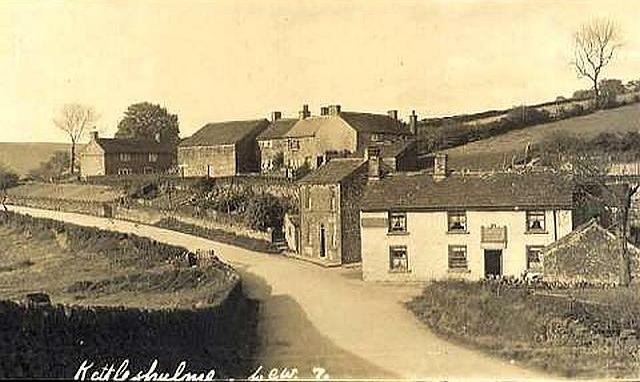
The picture above shows the Swan Inn, Kettleshulme, the white building in the foreground, some time around 1900; the general scene looks much the same in 2010 with the addition of the outside seating area and the traffic on the road. To the left of the inn is Smithy House. On the hillside behind are Ely Fold Cottages and Ely Fold Farm.
The 1841 census lists the Inn as the 'Smithy Door' - it was adjacent to the village smithy and the Publican was John Dewsnap (age 45) who lived there with his wife Hannah (50), son Hugh (20, cotton piecer), daughters Catherine (15), Mary (15), and sons Swann (12) and James (10). Can it be pure coincidence that curiously-named Swann Dewsnap was a resident?
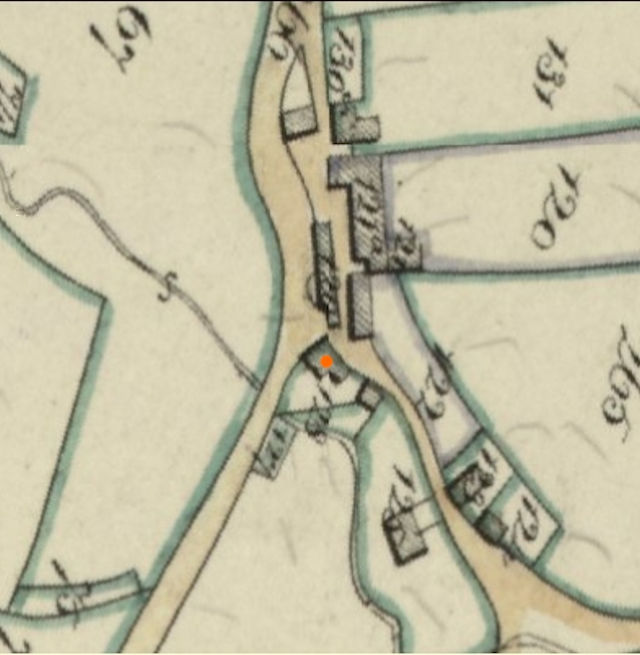
The tithe map of c. 1849 shows the Inn, plot 128; our orange mark pinpoints it. The associated text shows the name as the Swan Inn, and John Dewsnap as both owner and occupier, quite unusual at the time when most people were tenants. Plot 120, Ely Meadow, and 122, were owned by James Swann. The building immediately to the north of the inn was the smithy.
In 1851 it is named as the Swann Inn: the licensed Victualler is Jonathan Dewsnap (age 37) with his mother Hannah (60) described as retired victualler, and brother James (20), hand loom weaver. Jonathan was, perhaps we can assume, an elder son who had been living away - perhaps the Jonathan Dewsnap is shown in 1841 working in a paper mill near Glossop - and returned to take over the pub after his father died (or left?) and his mother Hannah wished to retire.
1861 sees Jonathan still in charge, with his sister Mary Southern and her son Thomas the only other residents. In 1871 Jonathan, Inn Keeper (47) was living alone; at that time, living nearby in one of the Ely Fold Cottages was William Boothby (37, Quarry Man) with his wife Mary (42) and their children Alice (my great-grandmother), John, William and Mary.
Jonathan, who never married, died on 1 December 1871, and his brother Hugh was granted administration of his effects (valed at under £100).
Hugh Dewsnap, born in Kettleshulme in 1821 and christened at Taxal Church on 22 April that year, gained employment in the local cotton industry; the 1851 census lists him as a 'cotton operative' living in Flatts Lane, Kettleshulme (near the Inn) with his wide Hannah and daughters Mary Hannah (5) and Martha (3) By 1861 he had left Kettleshulme to work as a cotton spinner in the New Mills area, and by 1871 had set up in business as a grocer in the Newtown area (now part of New Mills buy then in Disley), and was still in business as such in 1881, his home listed as 'Swann Inn Cottages' - confusingly this refers to the Swan Inn on the Buxton Road in Newtown, New Mills, not the one in Kettleshulme.
Living with Hugh in 1881 were his wife Hannah (aged 56, born Disley) sons John (26), Jonathan (19), James (15) and Hugh (12). However, Hugh is listed at 'The Swan' in Kettleshulme in Morrris's 1874 directory of Cheshire as well as an entry for him as 'Shopkeeper, Newtown.' Could it be that eldest daughter Martha Dewsnap, aged 20 by 1871, returned to Kettleshulme to run the pub?
My family's connection with the place begins on 28 September 1874, when John Thomas Boothby married Martha Dewsnap, daughter of Hugh and Hannah, at the Jenkin Chapel, Saltersford. John Thomas Boothby was a younger brother of my great-great-grandfather William Boothby.

John Thomas Boothby became the Publican; he died in 1888 and his widow Martha Boothby carried on alone as landlady (latterly assisted by her youngest daughter Maggie and her widowed father Hugh who is listed there in 1891 aged 70 and 'living on his own means'), until she died in 1911. The picture above dates from that period, as Martha's name is displayed above the door. An entry in a directory dated 1914 shows that her son Sampson Boothby (born in 1883) gave up his job as a shipping clerk in Manchester and took on the licence of the pub. He fought in World War I as a gunner in the Royal Artillery, but survived and lived until 1954. He married Lily A. Northam in 1912: she died in 1953.
A note on the Land Registry record for the pub suggests that by 1897 the Swan had become a 'tied house', being owned by Showell's Brewery, a Birmingham-based firm who had taken over Marsland's brewery in Hempshaw Lane, Stockport. In 1910 they in turn sold the brewery to Salford-based Walker & Holmfray's; more recently the Swan became a 'Free House' which it still remains.
Reading the superbly-crafted website 'A Family Album' dedicated to Freda Aldous, I was amused to note that while that lady was working as a teacher in Kettleshulme School in the early 1950s she met and married a local man named Sampson Boothby Fidler, son of local farmer George Alan Fidler who must have named him (born 1912) after Sampson Boothby. Perhaps he was a regular at the Swan Inn ...
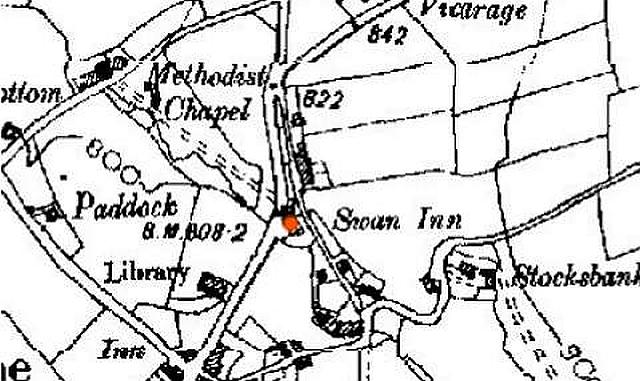
This map from 1910 shows how the old route from Macclesfield to Whaley Bridge passed to the east of the Swan Inn and headed off at the top centre of the map towards Kishfield Bridge and the very steep climb up to Start Lane. The 1770 turnpike passes the other Inn, the Bull's Head, at the bottom of the map and leaves past the Vicarage. The Swan Inn lines on the 800 feet above-sea-level contour line.
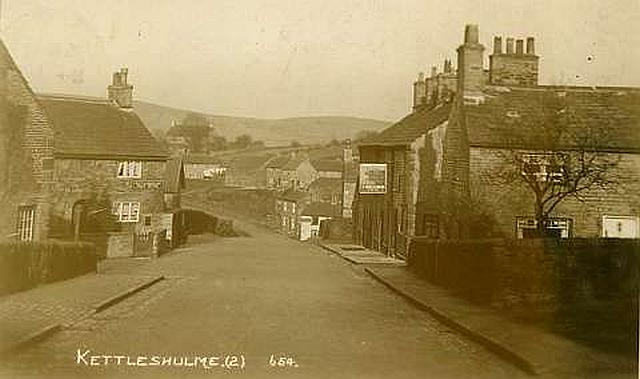
The card above was posted in 1915. The picture was taken looking along the main road towards Whaley Bridge. The sign of the Bull's Head pub can be seen in the right foreground: the white-pained Swan Inn stands out in the dip beyond.
No family records of the 'Swan Inn' side of the Boothby family have, unfortunately, passed down to me. This may be explained by the fact that the descendants of John Thomas Boothby's brother William were members the Methodist church with its strict taboo on drinking and gambling, so perhaps did not associate much with their pub-owning relatives.
Page compiled by Charlie Hulme, December 2010. Updated August 2017 . All comments and corrections welcomed: info[at]nwrail.org.uk